
Stagflation Investment Idea – Part I: Multi-family residential real estate
Inflation discussions typically focus on the price side of the inflation equation, but the income and expenditure side shows how households are responding to changing prices, especially wages and other income relative to goods and services prices. As part of our ongoing quest to look for ways to move out of our Treasury bond position that we have been in since the year 2000, today we look at the residential rental real estate market
The latest BEA report on personal consumption expenditures (PCE) comparing September to August 2010 begins:
"Personal income decreased $16.8 billion, or 0.1 percent, and disposable personal income (DPI) decreased $20.3 billion, or 0.2 percent, in September. Personal consumption expenditures (PCE) increased $17.3 billion, or 0.2 percent."
Rising expenses and falling incomes is the definition of stagflation. 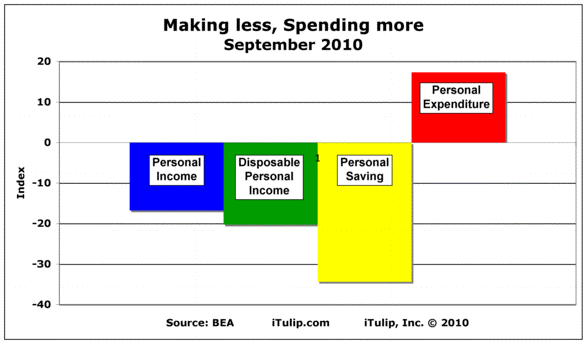
This is not a one-month phenomenon. The trend for 2010 is personal income, disposable personal income falling faster than PCE. It’s the relative rates of change that is creating economic pain for millions of Americans now living through the Transitional Economy, as explained in The Postcatastrophe Economy: Rebuilding America and Avoiding the Next Bubble
 .
.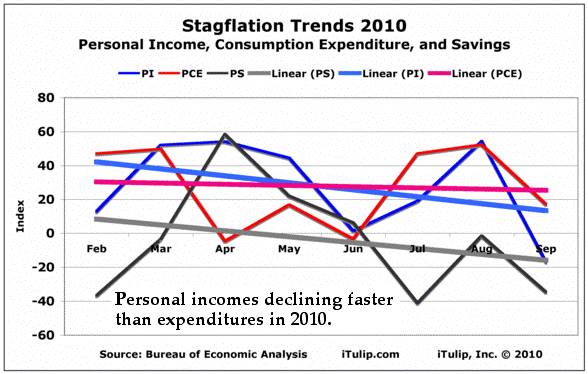
What can we, as investors, do to manage through this period? Is there a way to mitigate its impact on our savings?
Taking a closer look at the income data, we see clear trends in rental, interest, and dividend income. Income from interest is falling – big surprise with rates near zero. But rental income is rising steadily.
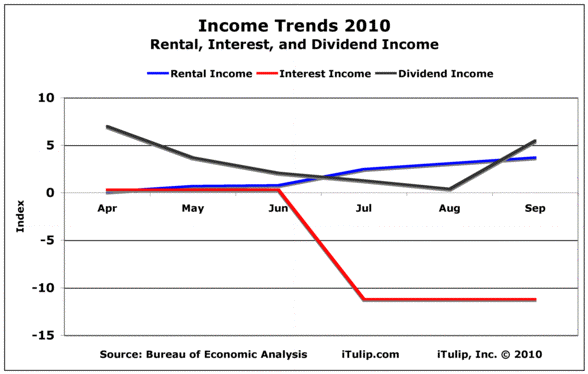
Independent tracking of national residential rent trends aligns with our July 2008 forecast (see Housing Bubble Correction Update: Here comes the jobs crash (Part I)) Competition for rentals is stronger in regions of the country where the job market attracts migrants from states where jobs growth remains weak, while reducing rental competition and prices in the regions the migrants left behind. In that mid-2008 analysis we identified Energy Price Inflation States (e.g., Texas) as good potential markets for housing rent and price appreciation, and Ground Zero States “where housing speculation itself was a major driver of incomes and employment during the bubble, such as in Florida, Arizona, and California” as areas to expect falling rents and prices.
The data from the site http://rentbits.com corroborates the forecast.
Rents advance in Atlanta...
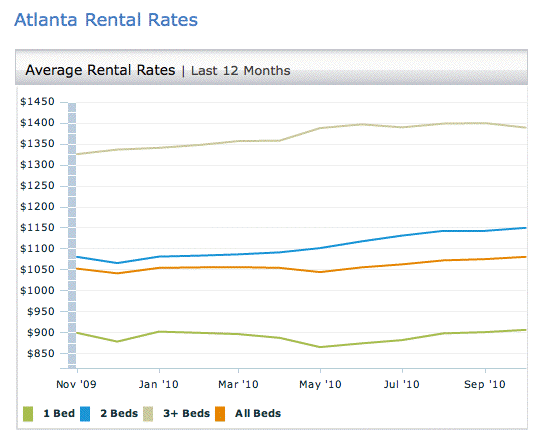
...heighten in Houston...
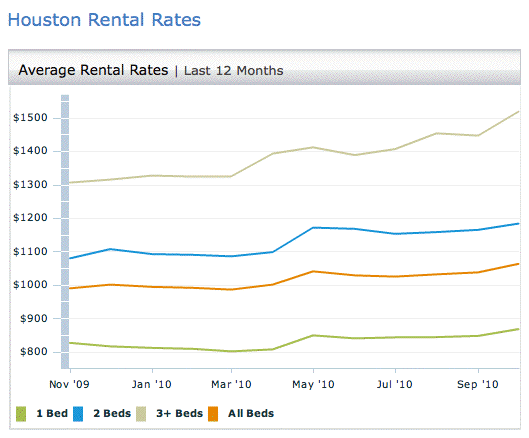
...boom in Boston...
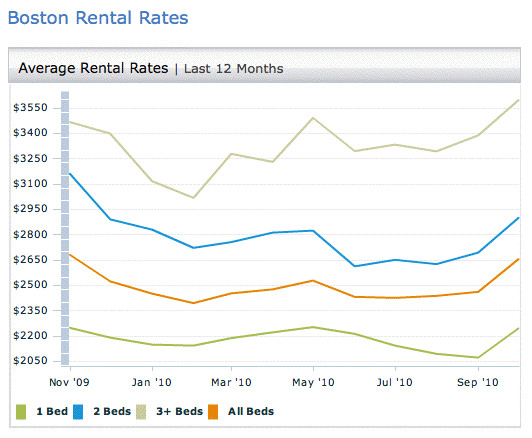
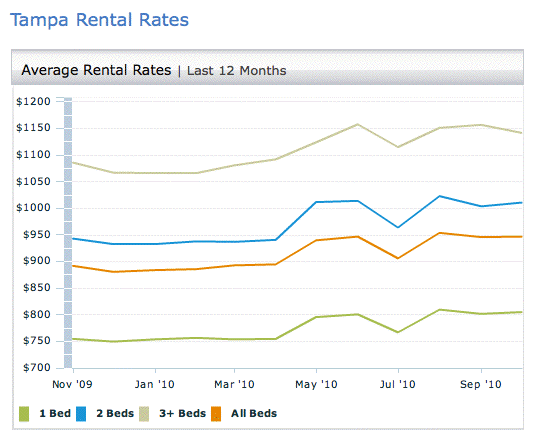
But they are flat in Phoenix...
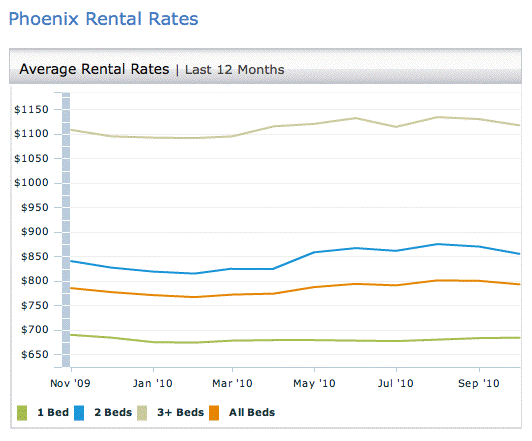
...and are dipping in Detroit
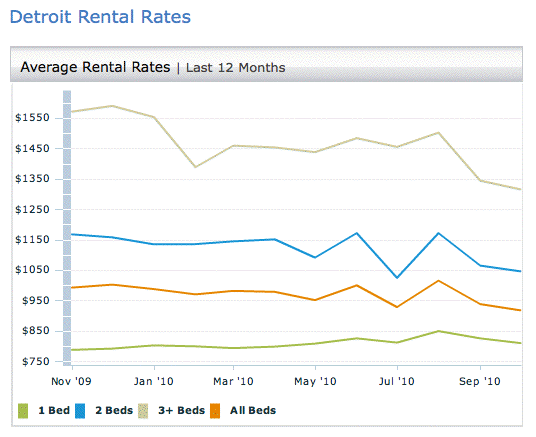 .
. In addition to the migration “pull” effects of high energy prices and “push” effects of the collapsed housing bubble, the trend away from home buying and toward renting is becoming cemented in the minds of both sufferers of negative equity and those who have seen the prices of their home collapse since 2006.
A May 2010 Real Estate Channel article “Will Growing Rental Trends Undermine U.S. Home Sales?” states:
There is a far-reaching change occurring now which threatens housing markets around the country. A survey conducted by Harris Interactive for the National Apartment Association in May 2010 found that 76% of those surveyed now believe that renting is a better option than buying in the current real estate market, up from 71% in 2008. Especially sobering was the fact that 78% of those surveyed were homeowners.
David Neithercut, CEO of Equity Residential, the nation's largest multi-family landlord, believes that there is a "psychology change" in the mind of consumers. In a June address to an industry conference, he declared that there is "a change in one's thought process about the benefits or wisdom of owning a single-family home.
But the article also notes that the “End of the Housing Bubble Led to a Surge in Houses Available to Rent,” causing rents to fall. That may still be true for the home rental market but not for the multi-family apartment rental market. David Neithercut, CEO of Equity Residential, the nation's largest multi-family landlord, believes that there is a "psychology change" in the mind of consumers. In a June address to an industry conference, he declared that there is "a change in one's thought process about the benefits or wisdom of owning a single-family home.
An August 2010 National Apartment Association report begins:
“Over the past 12 months the apartment industry has faced some of its greatest operating challenges in decades. It did not matter whether the owner or operator was a public or private company, a large or small organization, or based in any particular region of the country; the impact of the economic downturn, historically high level of unemployment, lack of meaningful job creation, declining rents, and significant declines in both transaction volume and asset values placed a greater emphasis on operation performance and bottom line metrics. However, the challenges over the past year appear to be “bottoming out” for the multifamily sector, and there are signs that over the next 12 to 36 months, there will be significant improvement in operating performance. Rents are beginning to rise, concessions are slowly declining, investor interest has increased and a renewed emphasis on managing the bottom line at the property and portfolio level is underway.”
If a trend toward higher multi-family apartment rents in Energy Price Inflation states, and those that benefit from dollar depreciation will be with us through the Transitional Economy, might there be a way to invest in this trend without the aggravation of becoming a landlord? We continue our exploration of alternatives to our Treasury bond allocation by reviewing a fund aimed at the multi-family apartment market.
Stagflation Investment Idea – Part II: Here come the funds
I recently reconnected with my friend Eric Silverman, partner in Eastham Capital, based in Needham, Mass. Turns out he is in the later stages of raising a fund that may fit the iTulip investment thesis. Asked if he thinks his multi-family residential real estate fund might make a good inflation hedge he replied, "Inflation? Rents are inflation. They’re 40% of consumer expenditure!" Reviewing the most recent Bureau of Economic Analysis (BEA) data, I’d say he’s got a point. more... ($ubscription)
Special Announcement: New Series of iTulip Select Webinars
We are holding a regular series of webinars according to the schedule here.
The Webinars are exclusive for iTulip Select Premium Members. If you are interested in attending this and future webinars and not an iTulip Select member? Please visit here for details. Questions? - Contacting Us
iTulip Select: The Investment Thesis for the Next Cycle™
__________________________________________________
For a concise, readable summary of iTulip concepts read Eric Janszen's September 2010 book The Postcatastrophe Economy: Rebuilding America and Avoiding the Next Bubble
 .
.To receive the iTulip Newsletter/Alerts, Join our FREE Email Mailing List
To join iTulip forum community FREE register now.
Copyright © iTulip, Inc. 1998 - 2010 All Rights Reserved
All information provided "as is" for informational purposes only, not intended for trading purposes or advice. Nothing appearing on this website should be considered a recommendation to buy or to sell any security or related financial instrument. iTulip, Inc. is not liable for any informational errors, incompleteness, or delays, or for any actions taken in reliance on information contained herein. Full Disclaimer